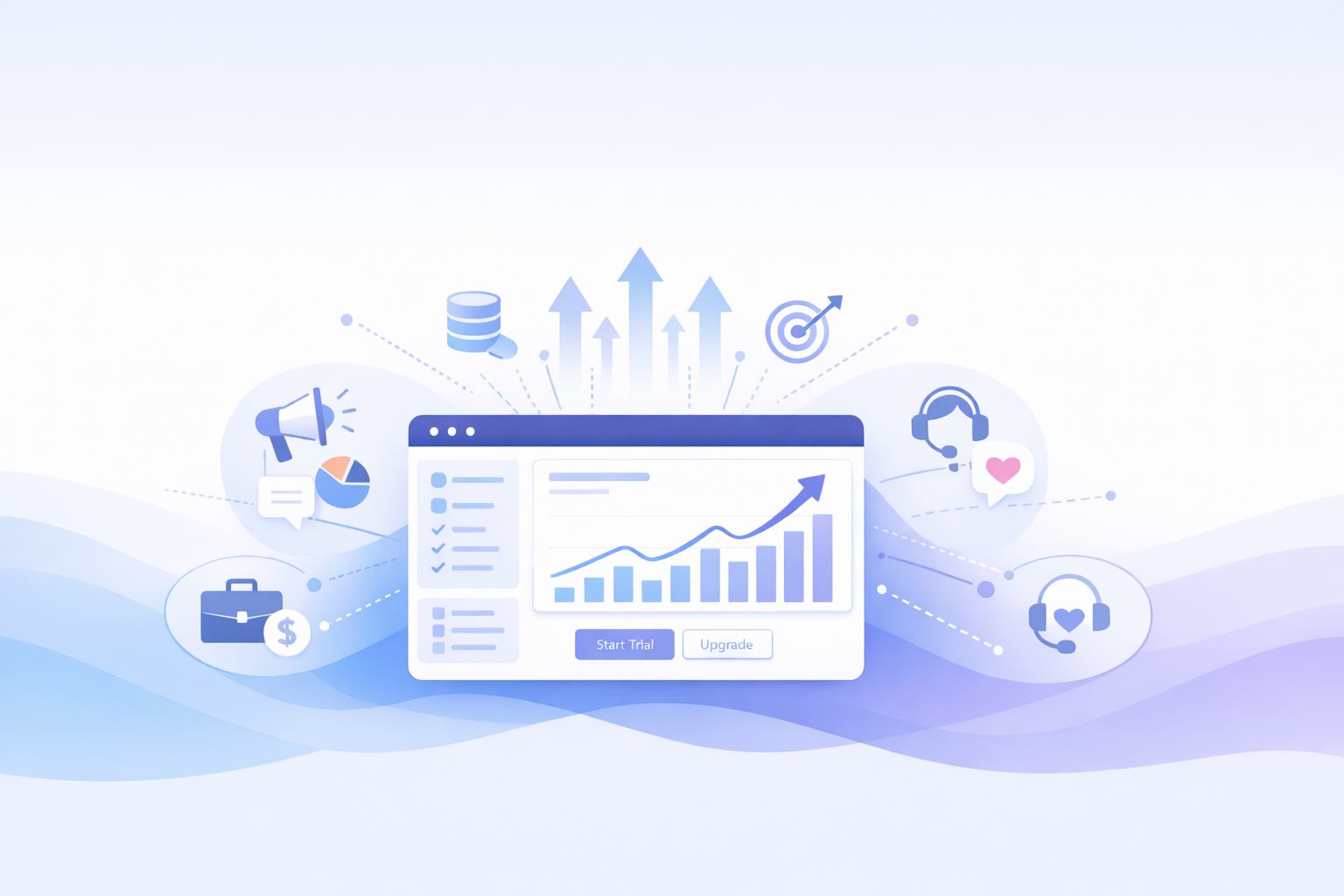How to Build an Effective Marketing Attribution Dashboard: Key Steps, Best Practices and Templates

How to Build an Effective Marketing Attribution Dashboard: Key Steps, Best Practices and Templates

Summary:
- Marketing attribution dashboards aggregate data from all marketing channels into a unified view to show how each touchpoint contributes to conversions and revenue, enabling clear performance insights and ROI evaluation.
- Key metrics include revenue, ad spend, Return on Ad Spend (ROAS), Click Through Rate (CTR), Cost Per Click (CPC), Cost Per View (CPV), conversion rate, cost-per-conversion, average customer value, bounce rate, and time to conversion.
- Attribution models determine how credit is assigned across touchpoints. Models include first-touch, last-touch, linear, time-decay, position-based, and data-driven. Choose one aligned with your sales cycle and business goals.
- To build a marketing attribution dashboard, define objectives and KPI’s, centralize your data, select the appropriate attribution model, choose the right tools, configure or visualize your dashboard elements, and continually monitor performance.
- Best practices for maintaining marketing attribution dashboards include tailoring views for stakeholders, repeatedly testing for accuracy, and iterating based on evolving goals and feedback.
Without a clear, consolidated marketing attribution dashboard, tracking ROI and justifying spend across channels is a guessing game—one that can cost you leads and eat up your budget.
The good news is that setting up a marketing attribution dashboard that works for you isn’t as far-fetched as it might seem.
We prepared a blueprint you can use and outlined the key steps, best practices, and templates to get your dashboard up and running in hours instead of days (or even weeks).
Let’s build a dashboard that gives you answers, not more questions.
What is a Marketing Attribution Dashboard?
A marketing attribution dashboard is an analytics tool that consolidates data from various marketing channels to help marketers understand how each touchpoint contributes to a customer's journey and conversion.
Here's a breakdown of what it does:
- Data aggregation: The dashboard pulls data from every channel—websites, emails, social media, ads, and more—giving you an all-in-one overview of all customer interactions.
- Performance insights: It helps you interpret the data and shows you which specific marketing campaigns, channels, and strategies have the highest conversions and the best ROI.
- Attribution modeling: The dashboard uses various attribution models (like first-touch, last-touch, linear, or time-decay) to assign value to each interaction in the customer journey. This gives you granular insight into how each touchpoint contributes to your end goals and you can refine your strategy based on factual performance data.
- Data visualization: Clear visuals—charts, graphs, reports—make it easier to extract actionable insights from the data, spot patterns, monitor trends, and present findings to stakeholders.
- Customization and segmentation: The dashboard lets you customize views and segment data based on factors like demographics, geography, customer behavior, or similar ones.
- Integrates with other tools: Most specialized software integrates with your existing marketing tools and platforms (such as CRM systems and analytics software) to ensure seamless data flow and comprehensive reporting.
Here’s one excellent marketing attribution dashboard example from HockeyStack’s template library.
This Marketing and Channel Overview Dashboard provides a comprehensive analysis of how each of your digital channels contributes to conversions.
Key elements of this dashboard include month-to-date and month-on-month performance reports that show metrics such as ad spend, Sales Qualified Leads (SQLs), pipeline, and revenue in real time.

Here are some other key elements that are included:
- Users can adjust date ranges and set performance goals to track progress accurately, with breakdowns available by regions, sources, or target accounts.
- The dashboard’s SQL and opportunities over time report enables in-depth analysis of lead quality and trends across specific timeframes, such as weekly or monthly periods. Marketers can use the data to monitor marketing campaign success, refine budgeting plans, and anticipate ad spend adjustments as needed.

- Target account data tracking is another powerful feature that allows you to monitor how target accounts progress through the sales funnel. Use this to assess the quality of leads at each funnel stage and optimize strategies to improve conversion rates.

With intuitive charts and graphs, the dashboard makes complex marketing data easy to understand, so you can spot trends and make decisions based on real-time data points.
14 Metrics to Consider Including in Your Marketing Attribution Dashboard
Here are some of the most important metrics you should consider adding to your attribution dashboard:
- Revenue: The total income you generate from your marketing efforts. Tracking revenue helps you understand which campaigns and channels are driving sales and contributing most to your bottom line.
- Ad spend: The total amount of money your company invested in advertising across all channels. You should monitor ad spend to better assess budget plans and optimize spending.
- Return on ad spend (ROAS): ROAS calculates how much money you've made for every dollar you spend on ads.
- Impressions: Impressions refer to the number of times your ad or content is displayed to users. While not a direct measure of conversions, this metric shows the reach and visibility of your marketing activities.
- Click-through rate (CTR): The proportion of users who clicked on your ad or link compared to the total number of impressions. A higher CTR indicates your ad is effectively driving traffic to your product.
- Cost-per-click (CPC): CPC is the amount you pay each time someone clicks on your ad. Keeping an eye on CPC helps you manage advertising costs and improve bidding strategies.
- Cost-per-view (CPV): CPV is the average cost for each view of your video ads.
- Conversion rate (CVR): The percentage of site visitors who completed a desired action (like making a purchase or signing up) out of the total number of visitors.
- Cost-per-conversion (CPCV): Also known as cost-per-acquisition (CPA), this metric calculates the average cost to acquire a customer and it includes all associated expenses.
- Average customer value (ACV): The average revenue you generate per customer over a specific period. It helps you understand the immediate value of customers acquired through your marketing and find high-value segments.
- Link clicks: The total number of times users clicked on links in your ads or content.
- Bounce rate: The percentage of visitors who leave your website after viewing only one page. A high bounce rate may mean you likely have issues with landing page content, relevance, or load times.
- Channel-specific ROI: Assess the return on investment for each marketing channel individually. This lets you see which channels deliver the best performance and deserve more investment.
- Time to conversion: Tracks the average time it takes for a prospect to convert after their first interaction.
How to Build a Marketing Attribution Dashboard in 6 Steps
Here's a step-by-step guide you can follow to build your first marketing attribution dashboard without wasting weeks (and nerves):
1. Define Your Objectives and KPIs
You can start by outlining your primary marketing objectives – these should be specific, measurable, attainable, relevant, and time-bound (SMART).
For example, your objectives might include increasing online sales by 15% in the next quarter, improving lead generation by 25% through content marketing, or improving customer retention rates by 10% over the next six months.
Once your goals are clear, break them down into specific questions that your dashboard needs to answer. You want each component of your dashboard to serve a purpose:
- Which marketing channels are driving the most high-quality leads?
- What touchpoints are most influential in the customer journey?
- How do different customer segments respond to various marketing initiatives?
Then, go backward and see which KPIs directly align with each objective. Here’s an example:
- Objective: Increase online sales by 15% in the next quarter.some text
- KPIs: Total revenue, number of transactions, average order value, conversion rate.
- Objective: Increase lead generation by 25% through content marketing.some text
- KPIs: Number of new leads, content engagement metrics (e.g., time on page, scroll depth), conversion rate from content pieces.
- Objective: Improve customer retention rates by 10% over the next six months.some text
- KPIs: Churn rate, repeat purchase rate, customer lifetime value (CLV), Net Promoter Score (NPS).
Limit your dashboard to the most critical KPIs to avoid information overload - a good balance is usually 5-8 KPIs per dashboard.
Remember that different teams (e.g., marketing, sales, finance) rely on varied data points, so get input from stakeholders to ensure your KPIs reflect cross-functional priorities.
Marketing teams might prioritize CTR and engagement rates, while sales teams are more concerned with lead-to-customer conversion rates. You want to make your dashboard useful across multiple departments.
Once you have the KPIs, set realistic benchmarks or targets based on historical data, industry standards, or your specific growth targets. These benchmarks give your KPIs context, so you can see whether your performance is meeting, exceeding, or falling short of expectations.
2. Gather and Centralize Your Data
Time to outline all the relevant data sources involved in your marketing activities. These typically include:
- Website analytics: Data from tools like Google Analytics that track user behavior on your site.
- CRM systems: Information about customer interactions and sales from platforms like Salesforce or HubSpot.
- Advertising platforms: Metrics from Google Ads, Facebook Ads, LinkedIn Ads, and other paid channels.
- Email marketing services: Data from email campaigns managed through providers like Mailchimp, ActiveCampaign, or similar software.
- Social media platforms: Insights from organic and paid activities on platforms such as Twitter, Instagram, and LinkedIn.
- Ecommerce or sales data: Transactional data from your online store or point-of-sale systems.
Once you have these sources, the next step is to integrate them into a centralized repository. This could be a data warehouse, a customer data platform (CDP), or any centralized database that consolidates data and provides easy access.
Centralizing your data eliminates silos and you’ll make sure that all teams work with the same information and have a single source of truth for analysis.
For data integration, you should consider using APIs, data connectors, or integration tools that automate the extraction process. It's important to standardize the data formats during this process to ensure consistency.
You also need to pay attention to the quality of your data. Before you feed data into your dashboard, you need to go through a cleansing process to remove duplicates, correct inaccuracies, and handle any missing values.
Set up regular checks for accuracy, completeness, and consistency, so you’re 100% sure that your dashboard reflects real-time, actionable insights.
3. Select Your Attribution Model(s)
Attribution models determine how credit for conversions is assigned to different marketing touchpoints along the customer journey. The model you choose will influence your insights and marketing decisions.
You should first familiarize yourself with the different types of attribution models:
- First-touch attribution: Assigns all credit to the first interaction a customer has with your brand. Primarily useful for understanding which channels generate initial awareness.
- Last-touch attribution: Credits the final interaction (last-click) before the conversion. It helps find which channels are most effective at closing sales.
- Linear attribution: Distributes credit equally across all touchpoints and provides a balanced view of all marketing activities that contribute to a conversion.
- Time-decay attribution: Gives more credit to touchpoints that occurred closer in time to the conversion. It's beneficial when interactions nearer to the conversion are considered more influential.
- Position-based (U-shaped) attribution: This model allocates 40% credit to both the first and final interactions, with the remaining 20% evenly split among the middle interactions.
- Data-driven attribution: Uses machine learning algorithms to evaluate the impact of each touchpoint. It requires larger data sets but provides a customized attribution model based on actual customer behavior.
When selecting an attribution model, you need to consider the nature of your customer journey and the specifics of your business.
For example, a B2B sales cycle often involves multiple touchpoints and a longer timeline, making a multi-touch model like linear or position-based attribution more effective, as it can capture and credit each interaction throughout the journey.
If you’re working with a shorter sales cycle, typical in B2C, where conversions happen quickly, a last-touch attribution model may be sufficient.
If your goal is to understand both early and late-stage interactions, consider starting with position-based or time-decay attribution.
For more comprehensive insights, you can combine multiple models and compare them, so you have different perspectives on how each touchpoint impacts conversions.
4. Choose the Right Marketing Attribution Tool
With the right marketing attribution software, you can accurately track, analyze, and attribute customer interactions across all of your marketing channels.
Here are the main factors you should pay attention to:
- Ease of implementation: The tool should be user-friendly, with straightforward integration processes that don’t require extensive technical skills.
- Data integration capabilities: It should seamlessly connect with your existing marketing platforms, CRM systems, and data sources to centralize all relevant information.
- Attribution modeling options: Look for tools that offer multiple attribution models, including customizable ones to suit your specific business needs.
- Real-time analytics: Make sure you can track your dashboard data in real time.
- Reporting and visualization: Intuitive dashboards and customizable reports make it easier to interpret data and share insights with stakeholders.
HockeyStack is an example of a multi-touch marketing attribution platform that offers all this – and more.
Here are some of HockeyStack’s key advantages:
- Unified data platform: HockeyStack consolidates data from various sources—including website analytics, advertising platforms, and CRM systems—into a single dashboard.
- Advanced attribution models: The platform supports multiple attribution models such as first-touch, last-touch, linear, time-decay, and even customizable models.
- Real-time insights: You get access to real-time data so you can monitor campaign performance as it happens.
- Intuitive dashboards and reporting: HockeyStack provides user-friendly dashboards with customizable widgets and visualizations. The clear presentation of data makes it easier to interpret complex metrics and share insights with your team.
- Behavioral analytics: You can track user interactions at a granular level to better understand how customers engage with your content, which paths they take, and what influences their decisions.
- Segmentation and personalization: You can segment your audience based on various criteria such as behavior, demographics, or source.
5. Build Your Dashboard
With your objectives defined, data centralized, attribution model selected, and the right tools in place, it's time to build your marketing attribution dashboard.
You can follow these steps:
- Connect your centralized data repository to the dashboard platform, and set up an API integration or data connectors as needed. Make sure that the data is accurate and that all metrics are calculated according to your definitions. Pay special attention to date ranges, currency formats, and attribution windows to maintain consistency.
- Start organizing your KPIs and metrics in a logical sequence that reflects the customer journey or the marketing funnel stages. Place the most critical metrics, such as revenue, ROI, or conversion rates at the top and test visual elements like charts, graphs, and heat maps to represent data more effectively.
- Implement your selected attribution model within the dashboard. You may need to customize calculations or use built-in features. Test these configurations thoroughly to confirm that they align with your attribution strategy.
- Customize the dashboard to cater to different stakeholders. Create sections tailored for various team members—such as executives, marketing managers, or channel specialists—focusing on the metrics most relevant to their roles. You can even add filters so users can drill down into specific campaigns, channels, or customer segments.
- Include features like hover-over tooltips that provide additional context, clickable elements that lead to more detailed reports, and alerts that notify changes in key metrics.
- Test the dashboard before rolling it out. Check for data accuracy, load times, and usability across different devices and browsers. Get feedback from a small group of end-users to spot any potential issues.
- Educate users on how to use the dashboard, interpret the data, and leverage the insights for their specific functions. You can create documentation or user guides as reference materials.
- Regularly review and refine your dashboard’s layout and metrics to ensure it keeps pace with changing goals, new insights, and feedback from stakeholders. If, for instance, a new channel becomes central to your marketing strategy, adjust the dashboard to track its performance.
6. Monitor and Analyze Results
To get the most out of your dashboard, keep a close watch on key metrics—conversion rates, customer acquisition costs, and ROAS. By tracking these consistently, you’ll quickly spot trends that reveal what’s working and where there’s room to improve.
Use the dashboard to compare the performance of different digital marketing channels and campaigns as well. This allows you to double down on high-impact channels and rethink strategies for those underperforming.
Stay alert to any unexpected changes. Sudden shifts in metrics can signal outside factors, like market changes, or internal issues, such as data errors or technical glitches. You should be able to investigate these anomalies immediately to determine their causes and resolve them.
Ultimately, apply what you’ve learned to guide your strategy. If the data shows that a particular campaign is delivering a high ROAS, consider increasing investment in that area. If certain channels are not meeting performance expectations, find new ways to optimize them or move those resources to other areas.
6 Marketing Attribution Dashboard Examples to Inspire Your Own
To get a sense of what’s possible with a marketing attribution dashboard, let’s check out a few real-world examples that may be useful.
Google Ads Dashboard
A Google Ads Dashboard gives you a complete view of your Google Ads performance and it compiles data from your campaigns into a visual, easy-to-understand format.
Instead of combing through separate Google Ads reports, the dashboard centralizes all relevant data so you can make informed decisions quickly.
Some of the things you can measure with our dashboard:
- Campaign and keyword performance: You can analyze the effectiveness of individual campaigns and keywords and track metrics like impressions, clicks, conversions, CPA, and conversion rates to see which campaigns are delivering the best results.
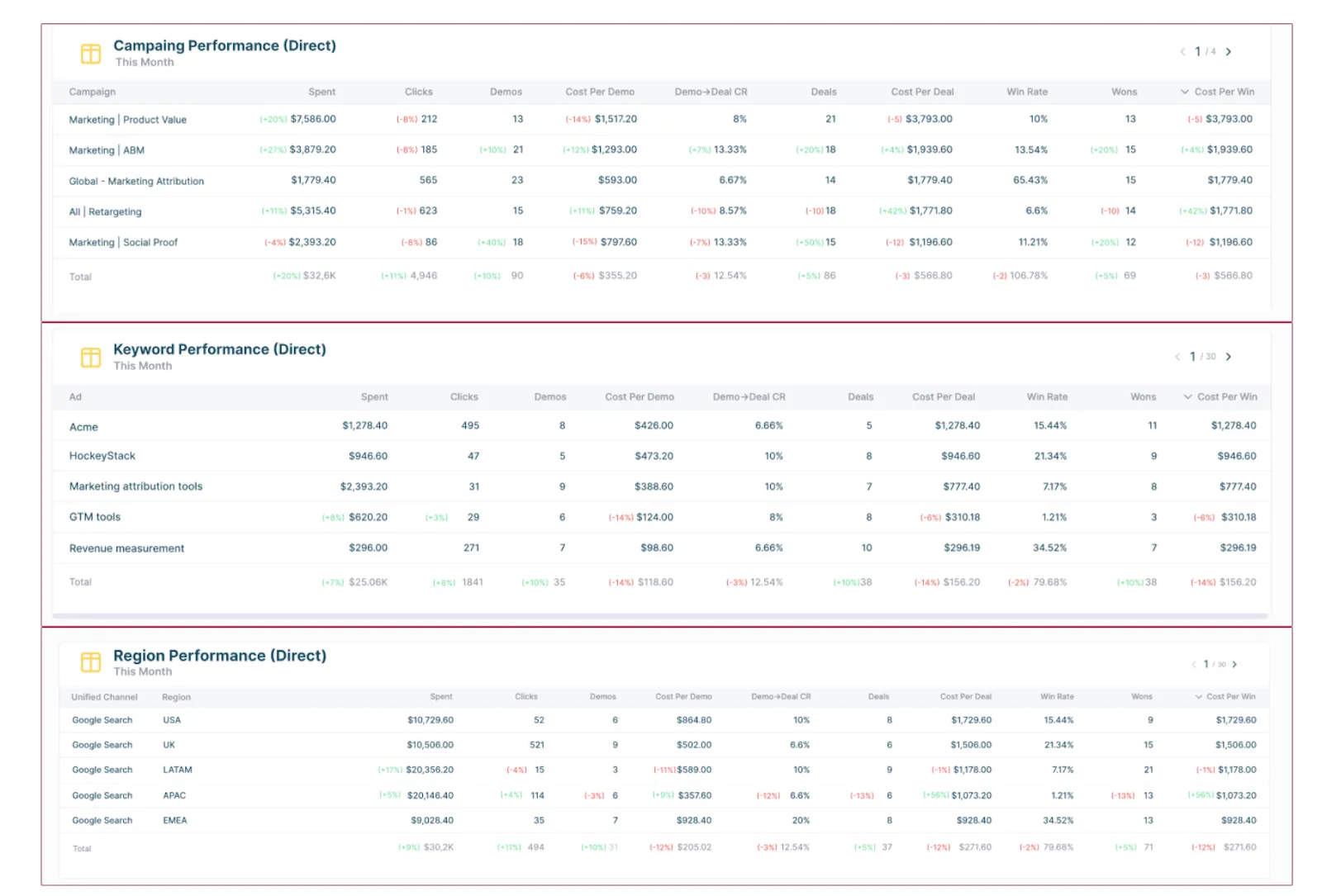
- Direct and assisted conversions: Google Ads don’t always lead directly to conversions – they can also play an important role in the multi-touch journey. The dashboard captures direct conversions (where an ad click led immediately to a conversion) and assisted conversions (where the ad was a touchpoint in a longer journey).
- Ad type and match type impact: You can assess different ad formats (such as responsive search ads vs. display ads) and keyword match types (exact, phrase, or broad).
- Spend and budget pacing: With a clear overview of daily and cumulative ad spend, this dashboard ensures you’re on track to stay within budget while still maximizing ad exposure.
- User journey insights: The Google Ads Dashboard provides a deep look into the customer journey, showing how ads contribute at different stages, from awareness to consideration to conversion.

Email Strategy ROI Dashboard
The Email Strategy ROI Dashboard combines your most important metrics related to email strategies into a single, user-friendly interface where you can monitor performance and optimize your email campaigns.
Some of the key things you can measure include:
- Email campaign performance analysis: Stay on top of metrics such as open rates, click-through rates (CTR), and bounce rates to assess the impact of your email campaigns.

- Performance over time: Analyze campaign performance across different periods to spot trends and patterns.

- User journey mapping: Visualize the customer journey from email engagement to closed deals, so you get direct insights into conversion rates at each funnel stage.

- Regional performance breakdown: Get a unified view of email campaign effectiveness across different regions.

- Email vs. other channels comparison: Use lift reports to measure the incremental impact of email marketing relative to other channels.
Blog Vitals Dashboard
The Blog Vitals Dashboard is designed to assess the impact of blog content on a company's revenue.
Unlike traditional metrics that focus on content consumption, this dashboard shows the blog's influence on the sales pipeline so content teams can demonstrate their contribution to revenue generation.

You can use it to measure:
- Meetings booked with blog touchpoints: Tracks the number of meetings scheduled by individuals who have engaged with the blog.
- Newsletter subscribers with blog engagement: Monitors the count of new newsletter subscribers who interacted with the blog.
- Sales win rates comparison: Compares win rates between prospects who viewed the blog and those who did not.
- Blog post performance (linear attribution): Uses a linear attribution model to assess which blog posts are most frequently visited by buyers in the pipeline so you can find high-performing content.

- Self-reported attribution with 'blog' mentions: Collects and categorizes customer feedback that references the blog as a discovery or decision-making factor.

LinkedIn Ads Dashboard
LinkedIn Ads Dashboard is a great tool if you need to analyze the effectiveness of your LinkedIn advertising campaigns and their direct impact on revenue generation.
With our dashboard, you can track things like:
- Overall performance by source: Assess the performance of different marketing channels, with a focus on LinkedIn ads, to determine their contribution to lead generation and revenue.
- Cost per call booking trends: Monitor the cost associated with securing call bookings over time.
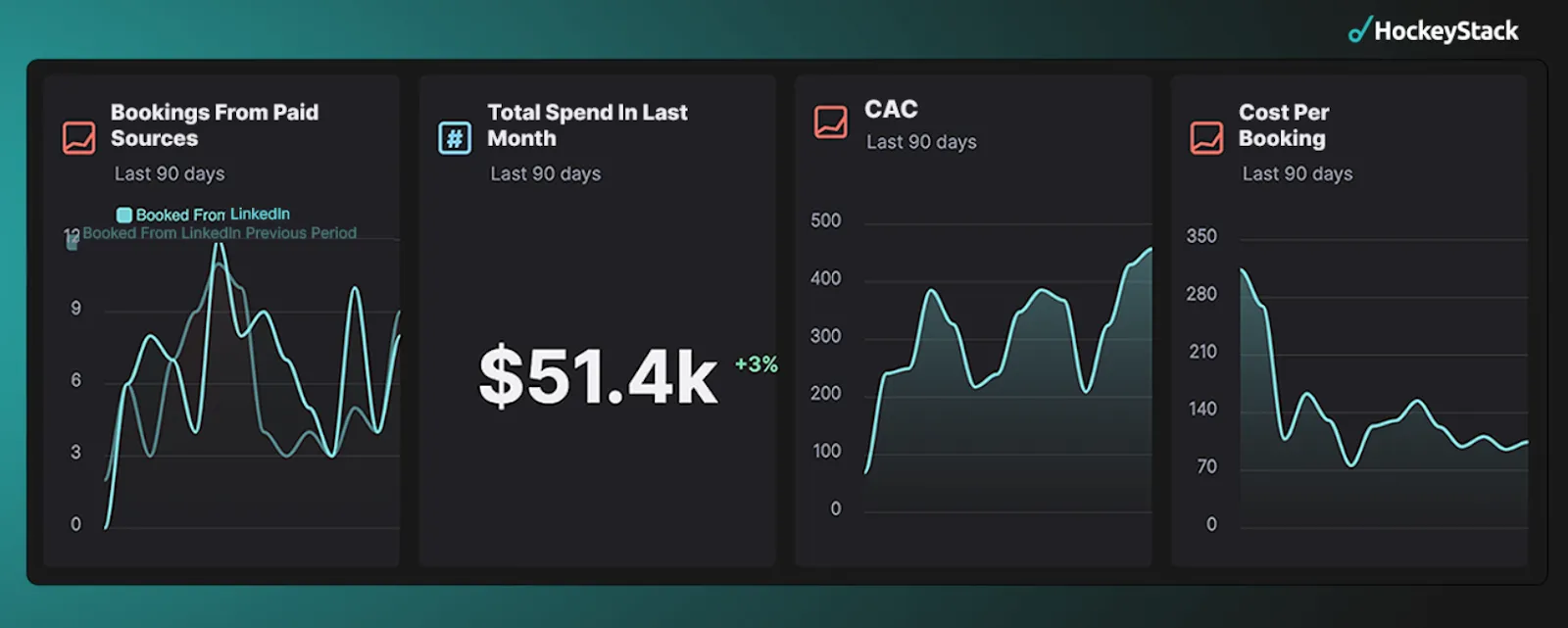
- LinkedIn ad creative performance: Analyze the effectiveness of different ad creatives by looking at metrics such as click-through rates (CTR) and conversion rates.
- Incremental lift of LinkedIn campaigns: Measures the additional impact of LinkedIn campaigns on key business outcomes to differentiate between organic growth and growth driven by paid advertising.

- LinkedIn campaigns influencing won deals: Identifies specific LinkedIn campaigns that have contributed to successful deal closures.
- Account journeys of high-intent buyers: Maps the interactions of high-intent buyers who have engaged with LinkedIn ads.
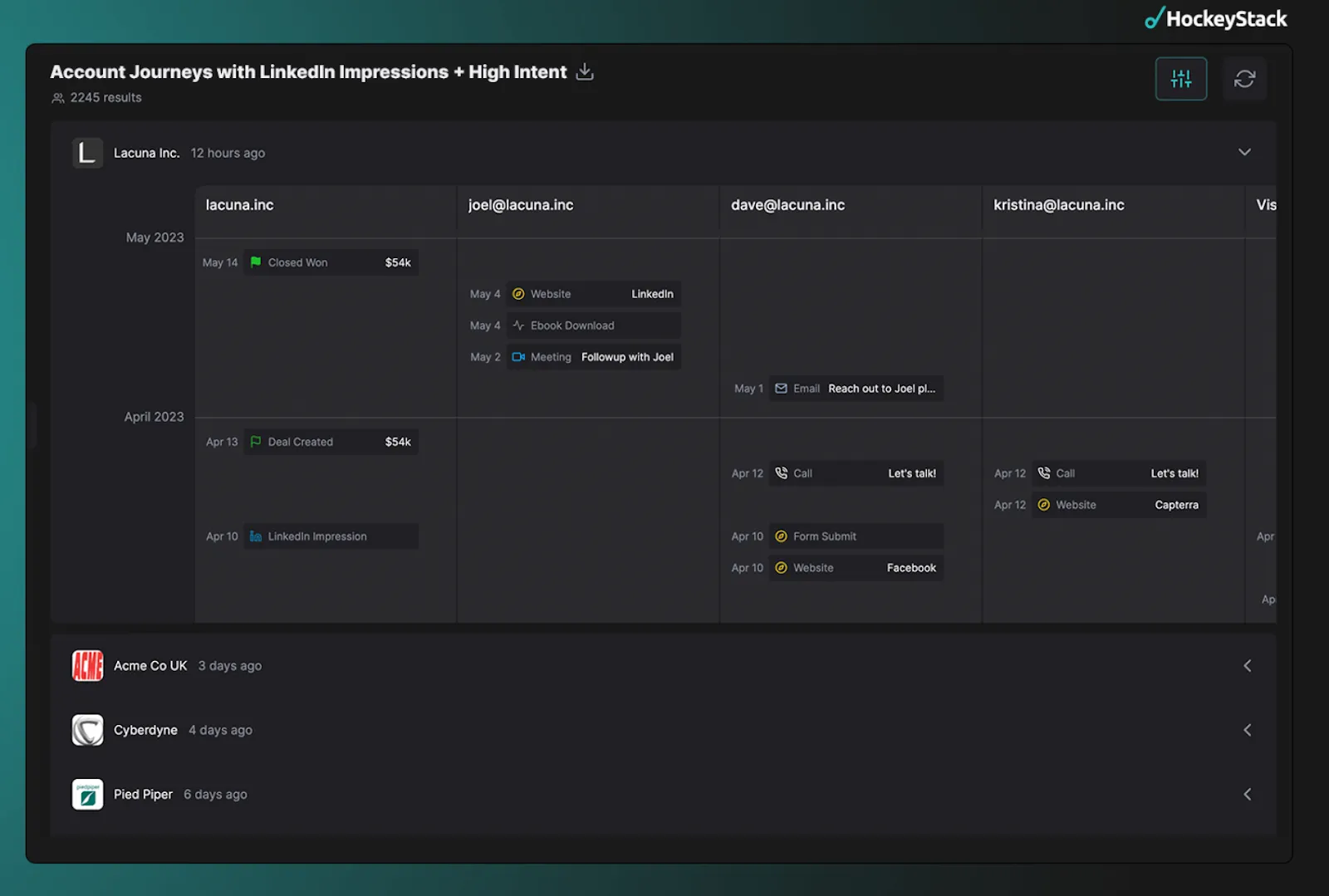
Funnel Performance Dashboard
The Funnel Performance Dashboard provides visibility into the performance of marketing and sales funnels within sales-led organizations.
You can use it to track critical metrics at each stage of the funnel to better monitor performance, spot bottlenecks, and optimize the customer journey.

The main things you can track include the following:
- Acquisition metrics: Tracks essential KPIs related to customer acquisition, such as lead generation, conversion rates, and cost per acquisition.
- Funnel metrics overview: Offers a detailed analysis of the customer and account journey through the sales funnel so you can find drop-off points.
- Marketing channel effectiveness: Analyze the performance of all your different marketing channels so you can find the most effective platforms for lead generation and conversion.
- Pacing and benchmarking: Monitors progress against marketing goals by comparing current performance with benchmarks based on three or six-month averages.
ABM and Intent Dashboard
ABM and Intent Dashboard can help you get insights into your account-based marketing (ABM) strategies and account intent signals.
You can use it to monitor key ABM metrics, assess the impact of various activities on deal success, and find accounts that show buyer intent signals.
The main things you can monitor include the following:
- Ad spend and target account list penetration: Shows spending on ABM campaigns and the percentage of target accounts reached through marketing and sales efforts.

- ABM impact analysis: See how effective ABM programs are by tracking signals such as previous customers transitioning to new accounts and accounts with significant new hires or promotions within the buying committee.

- ABM pipeline journey: Provides visibility into the journey of target accounts before conversion so you can find which activities contribute to pipeline creation.

- ABM intent monitoring: Aggregates intent data across targeted accounts to find those ready for conversion and those that need more engagement from your team.
Related reading: How to build an account-based marketing (ABM) dashboard?
Reinvent Your Attribution Strategy with HockeyStack
Marketing attribution dashboards help your organization see which channels and touchpoints are driving conversions, so you can make decisions based on real-world data and better plan your budget.
The benefits are clear – however, many organizations still operate without one because they think it’s too complex to build.
This is where HockeyStack steps in.
Here are just some of the reasons why you should choose HockeyStack to build your attribution dashboard:
- Unified data integration: HockeyStack effortlessly gathers data from all your marketing channels and centralizes it into one easy-to-understand dashboard. You can say goodbye to data silos and hello to a holistic view of your customer interactions.
- Advanced attribution models: With HockeyStack, you have access to a variety of attribution models, including first-touch, last-touch, linear, time-decay, and even customizable options. This flexibility ensures that you can assign credit accurately across all touchpoints in the customer journey, based on your specific business needs.
- Real-time analytics: Make timely, informed decisions with real-time data. HockeyStack's platform provides up-to-the-minute insights so you can adjust campaigns on the fly and spot new opportunities.
- Intuitive dashboards and visualization: The platform offers user-friendly dashboards with customizable reports and visualizations. Complex data becomes easy to understand and act upon.
- Behavioral analytics: Understand not just the "what" but the "why" behind customer actions, so you can refine your strategies for better engagement and conversion rates.
- Scalable and user-friendly: Whether you're a startup or an enterprise-level company, HockeyStack scales with your business. Its ease of implementation means you don't need a team of developers to get started—you can integrate and begin analyzing in no time.
With HockeyStack, you’ll have complete visibility into your marketing performance, knowing exactly where to invest for the highest returns, and confidently backing your decisions with solid data.
Don't let fragmented data and unclear attribution hold your business back any longer – book a demo with HockeyStack now.
FAQs
Benefits of using a marketing attribution dashboard
A marketing attribution dashboard helps marketers stop guessing about what works and make data-driven decisions. Here's how:
- Optimize your budget: You can find your most profitable channels and campaigns, and use that information to allocate your budget better.
- Tracks customer journeys with precision: Understand touchpoints and pathways your customers take so you can better target future campaigns.
- Improve campaign performance: Gain insights into which messages and creatives resonate best with your audience.
- Measure marketing return on investment (ROI): Accurately assess the return on your marketing investments so you can demonstrate the value of your efforts to stakeholders.
- Improves team collaboration: When all departments see unified data, it’s easier to align strategies and work toward shared business goals.
What are the most commonly used marketing attribution models?
Marketing attribution models determine how credit for a conversion is assigned to different touchpoints in the buyer journey.
Here are some of the most common ones:
Single-touch attribution models
Single touch or click attribution models include:
- First-touch attribution: Gives all the credit to the first touchpoint.
- Last-touch attribution: Gives all the credit to the last touchpoint.
Multi-touch attribution models
Multi-touch or multi-channel attribution models include:
- Linear attribution: Distributes credit evenly across all touchpoints.
- Time decay attribution: This model gives greater credit to touchpoints that occur closer to the conversion event.
- U-shaped attribution: Gives more weight to the first and last touchpoints.
- W-shaped attribution: Similar to U-shaped, but also emphasizes a key middle touchpoint.
What are the top marketing attribution tools?
There are several powerful tools that can help you build and manage your marketing attribution dashboards:
- HockeyStack: A platform built for B2B SaaS that provides granular insights into user behavior and revenue attribution through event-based tracking. Offers customizable dashboards and integrates with popular CRMs and marketing tools.
- Google Analytics 4: A free and widely used platform that offers basic attribution modeling and website traffic analysis. It's a good starting point for businesses new to attribution.
- Looker Studio: A free tool for building custom dashboards with data from various sources, and also includes flexible visualization and attribution data reports.
- HubSpot: A popular, comprehensive marketing automation platform with built-in attribution reporting and a suite of marketing tools, including email marketing, CRM, and lead nurturing.
- Salesforce: A leading CRM with advanced attribution modeling and customizable dashboards, deeply integrated with Salesforce CRM data for comprehensive analysis.
- Adobe Analytics: An enterprise-level marketing analytics tool with advanced attribution modeling and predictive analytics that offers granular data insights and powerful segmentation.
HockeyStack Academy - Frequently Asked Questions
This is a hands-on FAQ section where you can find guidance on how to handle your most common issues

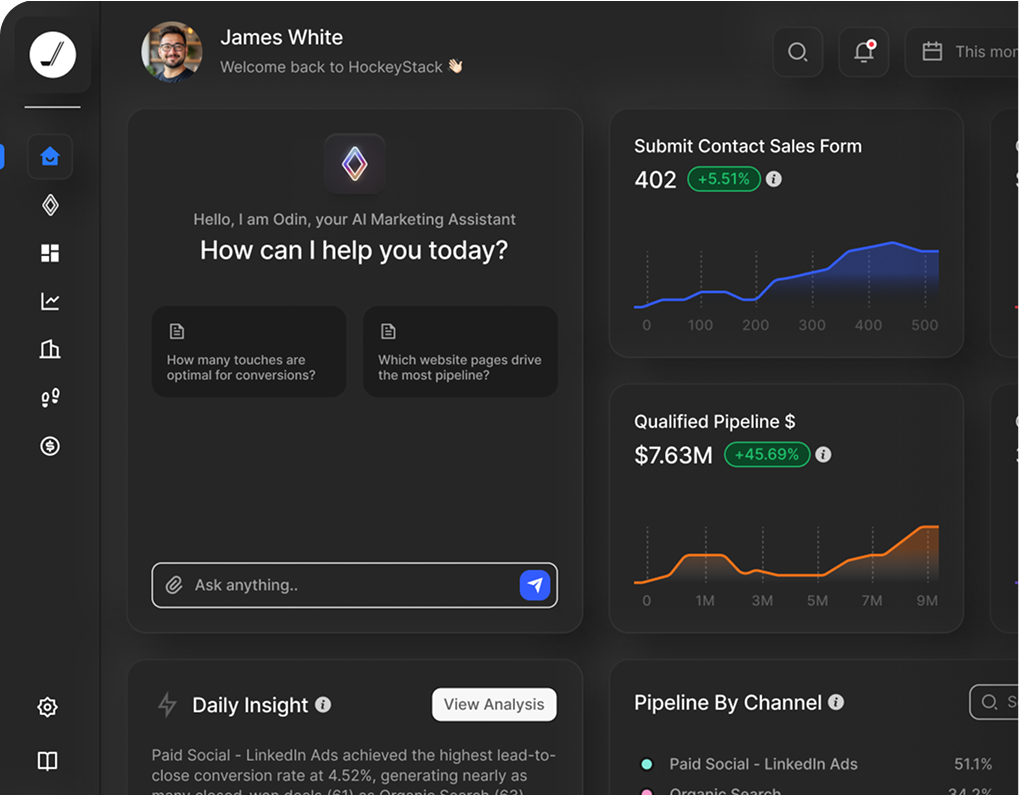
Ready to see HockeyStack in action?
HockeyStack turns all of your online and offline GTM data into visual buyer journeys and dashboards, AI-powered recommendations, and the industry’s best-performing account and lead scoring.
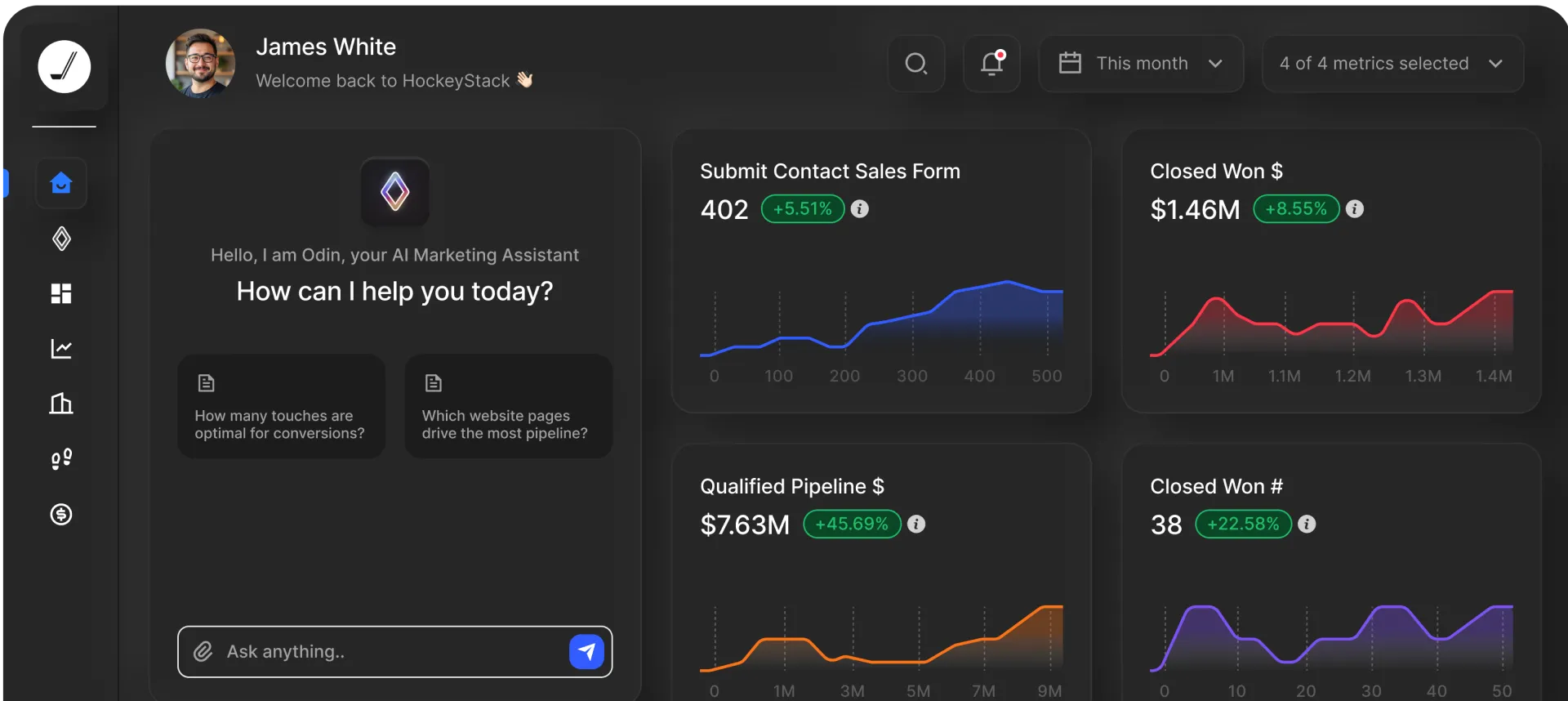
Ready to See HockeyStack in Action?
HockeyStack turns all of your online and offline GTM data into visual buyer journeys and dashboards, AI-powered recommendations, and the industry’s best-performing account and lead scoring.


